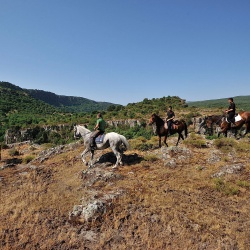

VIVA - New Active Tourism Itineraries in Villanova
Main sections of the site and Thematic sites
Main navigation

Padria descended from the Roman Gurulis Vetus
From the Nuragic Age to the churches in the scenery of the ancient Gurulis Vetus overlooked by three hills.
Technical info
Type
A pathway of historic and panoramic interest.
Degree of difficulty
Low difficulty route on easy terrain.
Time required
Approximately 3 hours.
Practicability
Walking and bicycle route.
Departure
Info point in town, piazza dei Balli.
Description
The route runs through the territory of Padria. From Via Nazionale in the direction of Pozzomaggiore, before the exit from the village, you get to Piazza del Convento Francescano (Franciscan Monastery), built in the seventeenth century and closed off until the second half of the nineteenth century by the Franciscan order of the ‘Frati Minori Osservanti’. The building which came into public use in 1870 was sold to private buyers before being acquired once again by the local municipality and restored. Next to the monastery is the Church of Santa Maria degli Angeli (St. Mary of the Angels), also known as the Church of Sant’Antonio (St. Anthony), built a little before the seventeenth century. It is characterised by a single aisle in the interior and six lateral recesses which contain altars made from wood and marble.
Travelling back along Via Nazionale after having turned to the left in the direction of Montresta and having followed the road which runs alongside the sports field for about 2 km, you get to the Nuraghe Longu. In an extremely dominant position, it is without doubt the best preserved monument of the entire territory. Returning to the village, going past the sports field, turn to the left and then continue in the direction of Montresta: about 100 metres from the edge of the village, via a small lane, you get to the Nuraghe Binzas. At the end of the climb that leads back to Padria, on the opposite side of the S.P. 11, there is the small Church of San Giuseppe (St. Joseph). Nearby it is possible to walk the path behind the hill of San Pietro (St. Peter) and have access to the town near the hill of San Paolo (St. Paul). Thus you get to the Church of Santa Croce, with an inscription on the façade which gives the date 1543 and is characterised by different phases of construction: currently the building is the headquarters of the Brotherhood of Santa Croce.
After having turned into Via Brigata Sassari you get to a small square with access onto the hill of San Paolo (St. Paul’s Hill) at the multi-stratified site of Palattu whose use dates back to the Nuragic era with continuity into the Phoenician-Punic Age, and Roman, Medieval and Post-Medieval periods. Walking along the streets of the old town centre, characterised by the presence of lintels sculpted from limestone from local “picapedras” with typical motifs from the Catalan school, you get to the Piazza del Comune (the Main Square) which is dominated by the Church of Santa Giulia (St. Julia’s Church), one of the most important buildings built in the Gothic Aragon style in Sardinia. In the same square, in the area of the former Monte Granatico, the Archeological Civic Museum includes a rich collection of materials from the Nuragic era, Punic and Roman periods and some of the most significant exhibits come from the prehistoric village of San Giuseppe.
Continuing along Via Nazionale it is possible to admire the Casa Piras, a private manor house, with its interior courtyards, a vaulted cellar, storerooms with iron frameworks and original furnishings from the nineteenth century.





